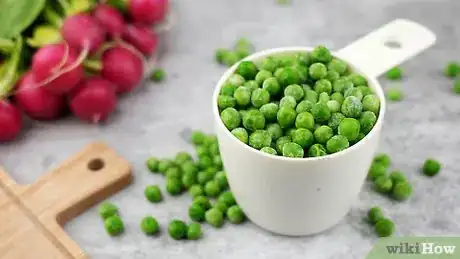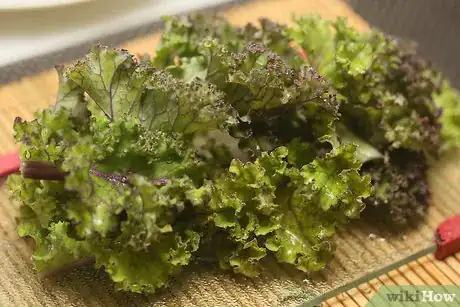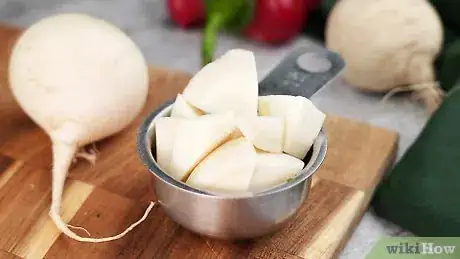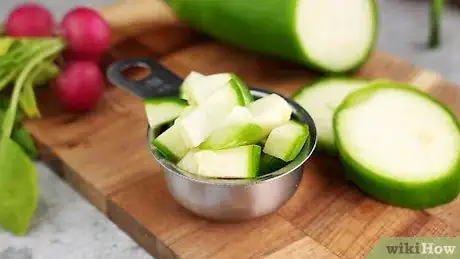This article was co-authored by wikiHow staff writer, Janice Tieperman. Janice is a professional and creative writer who has worked at wikiHow since 2019. With both a B.A. and M.A. in English from East Stroudsburg University, she has a passion for writing a wide variety of content for anyone and everyone. In her free time, you can find her working on a new crochet pattern, listening to true crime podcasts, or tackling a new creative writing project.
There are 8 references cited in this article, which can be found at the bottom of the page.
The wikiHow Culinary Team also followed the article's instructions and verified that they work.
This article has been viewed 32,283 times.
Learn more...
With all the extra ice and frost, frozen vegetables can be tricky to measure out in your favorite dishes. Not to worry! Frozen veggies are really easy to add and substitute in your recipes. Here are a few tips and tricks to help make your time in the kitchen a little easier.
Steps
Measuring Tips
-
1
-
2Note that frozen veggies are heavier than raw ones.[3] A lot of your favorite veggies and fruits are mostly made of water—in fact, the water is about 90% of a veggie’s total weight. When these veggies get popped in the freezer, the water expands as it freezes.[4]
- For instance, a ½ cup (67 g) of raw asparagus weighs 2.36 oz (67 g), while the frozen variety weighs 3.17 oz (90 g).
Advertisement -
3Defrost your frozen veggies in the refrigerator before cooking them. While you can definitely cook with frozen veggies, experts often recommend thawing them out beforehand, so they don’t lower the temperature of your dishes during the cooking process. You can leave certain frozen veggies, like bagged corn and peas, on the counter for a few minutes instead of defrosting them overnight.[5]
- It’s not a good idea to add completely frozen foods to dishes like stews or soups, since they’ll lower the temperature of the dish. Then, you may overcook the food while you wait for the temperature to rise again.
- You can simply rinse bags of frozen peas and corn under cold water instead of thawing them overnight.[6]
- Always thaw and wring out frozen spinach before you add it to any dishes.[7]
-
4Convert your vegetables from cups to ounces as needed. Vegetables come in all shapes and sizes, so there isn’t a one-size-fits-all measurement that applies to them all. Instead, convert vegetables individually for an exact measurement.[8]
- For a comprehensive list of raw, fresh, and frozen conversions, consult this chart: http://optaviamedia.com/pdf/LEARN/OPTAVIA-Vegetarian_Conversion_Chart.pdf.
- When measuring large quantities of veggies, remember that there are 16 oz in 1 lb (450 g).[9]
Frozen Veggie Conversions
-
1Asparagus: A ½ cup (90 g) of frozen asparagus weighs 3.17 oz (90 g). This is little heavier than ½ cup (121 g) of raw asparagus, which weighs 2.36 oz (67 g).[10]
-
2Bell Peppers: A ½ cup (68 g) of green or red peppers weighs 2.4 oz (68 g). Raw peppers, on the other hand, weigh 2.63 oz (75 g).[11]
-
3Broccoli: A ½ cup (92 g) of frozen broccoli weighs about 3.24 oz (92 g). This is a bit heavier than its raw counterpart, which weighs 1.55 oz (44 g).[12]
-
4Green Beans: A single, ½ cup (61 g) serving of cut whole, frozen green beans weighs 0.19 lb (86 g). If you have French green beans on hand, ½ cup (41 g) serving only weighs 0.16 lb (73 g).[13]
-
5Kale: A ½ cup (65 g) of frozen kale weighs around 2.29 oz (65 g). When raw, kale only weighs 1.18 oz (33 g).[14]
-
6Spinach: A ½ cup (95 g) of frozen spinach weighs around 3.35 oz (95 g). This is much heavier than raw spinach, which only weighs 1.06 oz (30 g).[15]
-
7Turnip Greens: A ½ cup (82 g) serving of turnip greens weighs 2.89 oz (82 g). Mustard greens are a little lighter—½ cup (75 g) is only 2.65 oz (75 g). Kale leaves are the lightest of all, with ½ cup (65 g) weighing just 2.29 oz (65 g).[16]
-
8Turnips: One ½ cup (78 g) serving of frozen turnips weighs 2.75 oz (78 g). This a little heavier than raw turnips, which only weigh 2.29 oz (65 g).[17]
-
9Zucchini: A ½ cup (111.5 g) of zucchini weighs 3.93 oz (111 g). Raw zucchini is a lot lighter, and only weighs 2.29 oz (65 g).[18]
References
- ↑ http://www2.readingeagle.com/article.aspx?id=119421
- ↑ https://www.washingtonpost.com/news/voraciously/wp/2019/10/25/frozen-vegetables-are-so-easy-to-cook-with-and-theyre-much-better-than-you-think/
- ↑ http://optaviamedia.com/pdf/LEARN/OPTAVIA-Vegetarian_Conversion_Chart.pdf
- ↑ https://extension.umn.edu/preserving-and-preparing/science-freezing-foods
- ↑ https://www.washingtonpost.com/news/voraciously/wp/2019/10/25/frozen-vegetables-are-so-easy-to-cook-with-and-theyre-much-better-than-you-think/
- ↑ https://www.cookinglight.com/cooking-101/techniques/cooking-with-frozen-vegetables-mistakes
- ↑ https://www.washingtonpost.com/news/voraciously/wp/2019/10/25/frozen-vegetables-are-so-easy-to-cook-with-and-theyre-much-better-than-you-think/
- ↑ http://optaviamedia.com/pdf/LEARN/OPTAVIA-Vegetarian_Conversion_Chart.pdf
- ↑ https://www.metric-conversions.org/weight/ounces-to-pounds.htm
- ↑ http://www.healthynoms.org/wp/wp-content/uploads/2017/02/vegetable-weight-conversion-chart.pdf
- ↑ http://optaviamedia.com/pdf/LEARN/OPTAVIA-Vegetarian_Conversion_Chart.pdf
- ↑ http://www.healthynoms.org/wp/wp-content/uploads/2017/02/vegetable-weight-conversion-chart.pdf
- ↑ https://mrs.mdek12.org/printables/mrs_cooks_tools_fresh_frozen_canned.pdf
- ↑ http://www.healthynoms.org/wp/wp-content/uploads/2017/02/vegetable-weight-conversion-chart.pdf
- ↑ http://www.healthynoms.org/wp/wp-content/uploads/2017/02/vegetable-weight-conversion-chart.pdf
- ↑ http://optaviamedia.com/pdf/LEARN/OPTAVIA-Vegetarian_Conversion_Chart.pdf
- ↑ https://mrs.mdek12.org/printables/mrs_cooks_tools_fresh_frozen_canned.pdf
- ↑ http://www.healthynoms.org/wp/wp-content/uploads/2017/02/vegetable-weight-conversion-chart.pdf

































































